Topic 7 - Magnetism & electromagnetism
1/30
There's no tags or description
Looks like no tags are added yet.
Name | Mastery | Learn | Test | Matching | Spaced |
|---|
No study sessions yet.
31 Terms
What do all magnets have? What’s a magnetic field? How can you show a magnetic field?
All magnets have two poles - north (or north seeking) and south (or south seeking).
All magnets produce a magnetic field - a region where other magnets or magnetic materials (e.g. iron, steel, nickel and cobalt) experience a force. (This is a non-contact force - similar to the force on charges in an electric field)
You can show a magnetic field by drawing magnetic field lines.
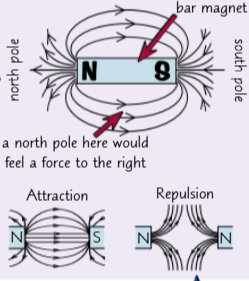
The lines always go from… (Magnets)? The closer together the lines are… & the further away…? The magnetic field is strongest at the…?
The lines always go from north to south and they show which way a force would act on a north pole if it was put at that point in the field.
The closer together the lines are, the stronger the magnetic field. The further away from a magnet you get, the weaker the field is.
The magnetic field is strongest at the poles of a magnet. This means that the magnetic forces are also strongest at the poles.
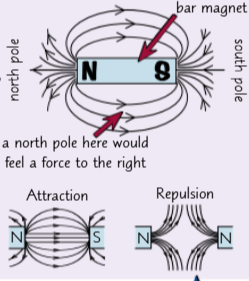
The force between a magnet and a magnetic material is…? If 2 poles of a magnet are put near each other… & what are these forces?
The force between a magnet and a magnetic material is always attractive, no matter the pole.
If two poles of a magnet are put near each other, they will each exert a force on each other. This force can be attractive or repulsive. Two poles that are the same (these are called like poles) will repel each other. Two unlike poles will attract each other.
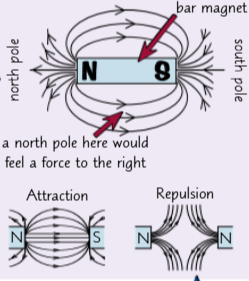
What’s inside a compass? How can you build up a picture of what the magnetic field looks like? What do compasses do when they’re not near a magnet?
Inside a compass is a tiny bar magnet. The north pole of this magnet is attracted to the south pole of any other magnet it is hear. So the compass points in the direction of the magnetic field it is in.
You can move a compass around a magnet and trace its position Oh some paper to build up a picture of what the magnetic field looks like.
When they're hot hear a magnet, compasses always point north. This is because the Earth generates its own magnetic field, which shows the inside (core) of the Earth must be magnetic.
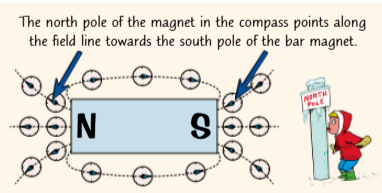
What are the 2 types of magnets? What do permanent magnets have? What do Induced magnets have?
There are two types of magnet - permanent magnets and induced magnets.
Permanent magnets produce their own magnetic field.
Induced magnets are magnetic materials that turn into a magnet when they're put into a magnetic field.
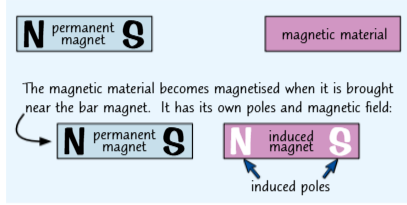
The force between permanent & induced magnets is..? When you take away magnetic field, induced magnets…?
The force between permanent and induced magnets is always attractive.
When you take away the magnetic field, induced magnets quickly lose their magnetism (or most of it) and stop producing a magnetic field.
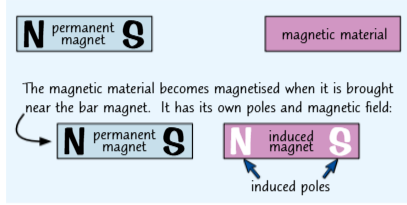
How is a magnetic field created around a wire? What is the field made up of? How can you see this? Changing the direction of the current..? The strength of the magnetic field produced changes with…?
When a current flows through a wire, a magnetic field is created around the wire.
The field is made up of concentric circles perpendicular to the wire, with the wire in the centre.
You can see this by placing a compass hear a wire that is carrying a current. As you move the compass, it will trace the direction of the magnetic field.
Changing the direction of the current changes the direction of the magnetic field - use the right-hand thumb rule to work out which way it goes.
The strength of the magnetic field produced changes with the current and the distance from the wire. The larger the current through the wire, or the closer to the wire you are, the stronger the field is.
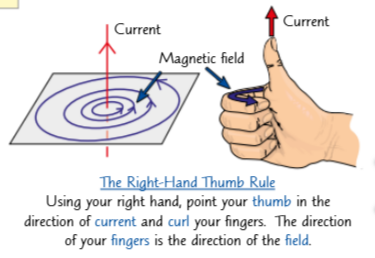
Whats a solenoid? How can you increase the strength of magnetic field in a solenoid? Why does this happen? What does this result in?
A Solenoid is a Coil of Wire
You can increase the strength of the magnetic field that a wire produces by wrapping the wire into a coil called a solenoid.
This happens because the field lines around each loop of wire line up with each other.
This results in lots of field lines pointing in the same direction that are very close to each other. The closer together field lines are, the stronger the field is.
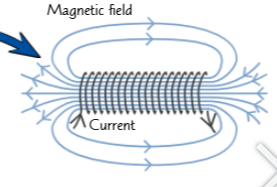
The magnetic field inside a solenoid is…? Whats the magnetic field outside the coil (solenoid)? How can you increase field strength of a solenoid even more? If you stop the current… & what’s a electromagnet?
The magnetic field inside a solenoid is strong and uniform (it has the same strength and direction at every point in that region).
Outside the coil, the magnetic field is just like the one round a bar magnet.
You can increase the field strength of the solenoid even more by putting a block of iron in the centre of the coil. This iron core becomes an induced magnet whenever current is flowing.
If you stop the current, the magnetic field disappears. A solenoid with an iron core (a magnet whose magnetic field can be turned oh and off with an electric current) is called an ELECTROMAGNET.
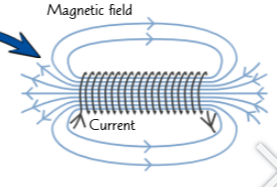
What creates a varying force? What are electromagnets used in & what does leading it mean? Where can they also be used & how?
Magnets you can switch on and off are really useful. They're usually used because they're so quick to turn oh and off or because they can create a varying force (like in loudspeakers)
Electromagnets are used in some cranes to attract and pick up things made from magnetic materials like iron and steel, e.g. in scrap yards. Using an electromagnet means the magnet can be switched on when you want to pick stuff up, then switched off when you want to drop it.
Electromagnets can also be used within other circuits to act as switches (e.g. in the electric starters of motors), like this:
When the switch in circuit one is closed, it turns on the electromagnet, which attracts the iron contact on the rocker.
The rocker pivots and closes the contacts, completing circuit two, and turning on the motor.
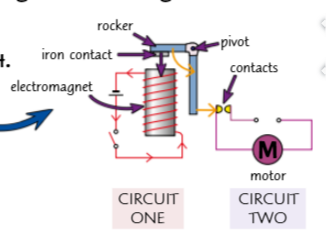
What’s the motor effect & what can it cause? To experience the full force…?
When a current-carrying wire (or any other conductor) is put between magnetic poles, the magnetic field around the wire interacts with the magnetic field it has been placed in. This causes the magnet and the conductor to exert a force on each other. This is called the motor effect and can cause the wire to move.
To experience the full force, the wire has to be at 90° to the magnetic field. If the wire runs parallel to the magnetic field, it won't experience any force at all. At angles in between, it'll feel some force.
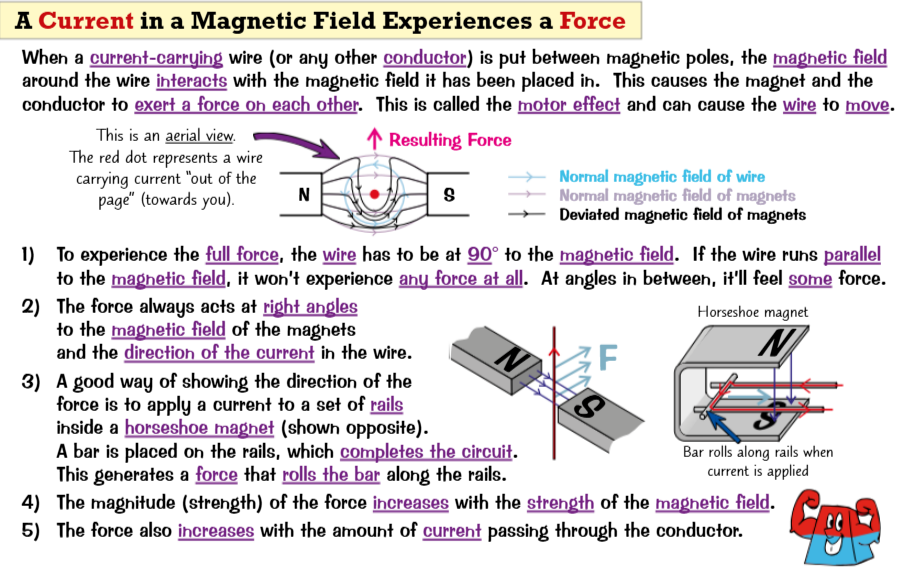
The force always acts at…(motor effect)? What’s a way of showing direction of the force? The magnitude of the force increases with…? The force also increases with the…?
The force always acts at right angles to the magnetic field of the magnets and the direction of the current in the wire.
A good way of showing the direction of the force is to apply a current to a set of rails inside a horseshoe magnet (shown opposite). A bar is placed on the rails, which completes the circuit. This generates a force that rolls the bar along the rails.
The magnitude (strength) of the force increases with the strength of the magnetic field.
The force also increases with the amount of current passing through the conductor.
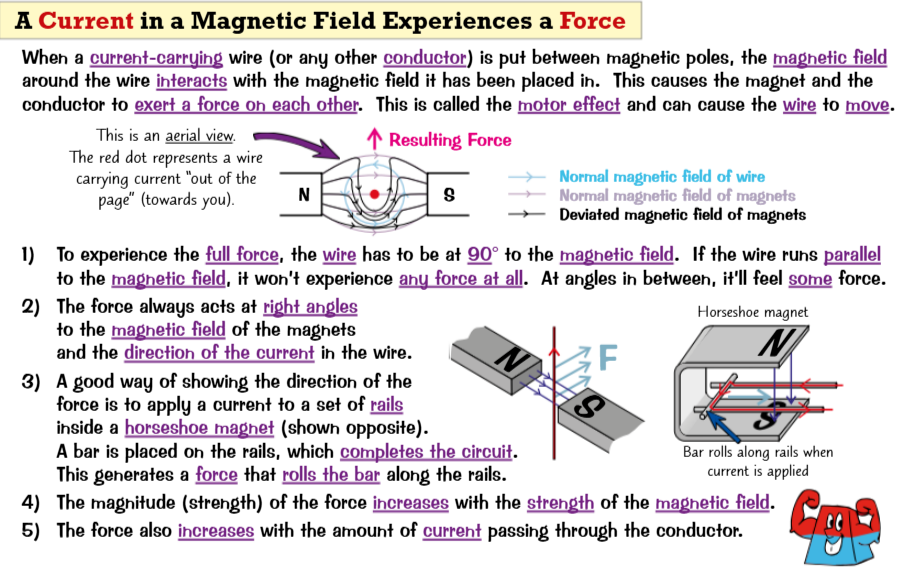
What are the 3 things the force acting on a conductor in a magnetic field depends on? When the current is at 90° to the magnetic field it is in…?
The force acting on a conductor in a magnetic field depends on three things:
The magnetic flux density - how many field (flux) lines there are in a region. This shows the strength of the magnetic field.
The size of the current through the conductor.
The length of the conductor that's in the magnetic field.
When the current is at 90° to the magnetic field it is in, the
force acting on it can be found using the F=BIL
F → force (N)
B → Magnetic flux density, (T, tesla)
I → current (A)
L → Length (m)
How can you find the direction of the force with Fleming’s left-hand rule?
You can find the direction of the force with Fleming's left-hand rule.
Using your left hand, point your First finger in the direction of the Field.
Point your seCond finger in the direction of the Current.
Your thuMb will then point in the direction of the force (Motion).
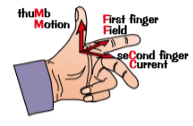
What does a current-carrying coil of wire do in a magnetic field? What’s a basic dc motor? What are these forces? Why do the forces act 1 up & 1 down?
A Current-Carrying Coil of Wire Rotates in a Magnetic Field
The diagram on the right shows a basic de motor. Forces act on the two side arms of a coil of wire that's carrying a current.
These forces are just the usual forces which act on any current in a magnetic field
Because the coil is on a spindle and the forces act one up and one down, it rotates.
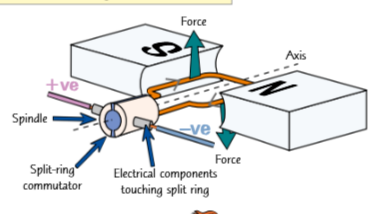
What does the split-ring commutator do? How can the direction of the motor be reversed? How can you work out which way the coil will turn?
The split-ring commutator is a clever way of swapping the contacts every half turn to keep the motor rotating in the same direction.
The direction of the motor can be reversed either by swapping the polarity of the dc supply (reversing the current) or swapping the magnetic poles over (reversing the field).
You can use Fleming's left-hand rule to work out which way the coil will turn.
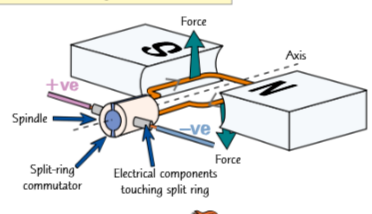
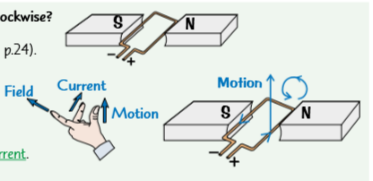
Is the coil turning clockwise or anticlockwise?
Draw in current arrows (from positive to negative)
Use Fleming's left-hand rule on one branch (here, I've picked the right-hand branch).
Point your first finger in the direction of the magnetic field (remember, this is north to south).
Point your second finger in the direction of the current.
Draw in the direction of motion (the direction your thumb is pointing in).
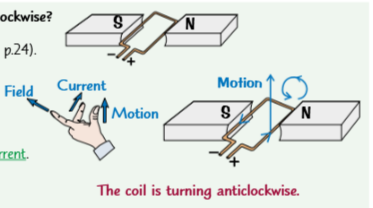
What do loudspeakers & headphones use? What’s sent through the coil of wire? The coil surround one pole of…? When the current reverses? Variations in the current cause? The frequency of the sound wave is…?
Loudspeakers and headphones (which are just tiny loudspeakers) both use electromagnets:
An alternating current (ac) is sent through a coil of wire attached to the base of a paper cone.
The coil surrounds one pole of a permanent magnet, and is surrounded by the other pole, so the current causes a force on the coil (which causes the cone to move).
When the current reverses, the force acts in the opposite direction, which causes the cone to move in the opposite direction too.
So variations in the current make the cone vibrate, which makes the air around the cone vibrate and creates the variations in pressure that cause a sound wave
The frequency of the sound wave is the same as the frequency of the ac, so by controlling the frequency of the ac you can alter the sound wave produced.
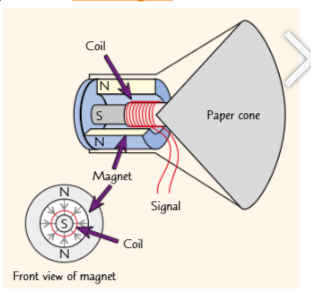
What’s generator effect? What does it create? How can you do this? what does shifting the magnet from side to side do?
The Generator Effect: The induction of a potential difference (and current if there's a complete circuit) in a wire which is moving relative to a magnetic field, or experiencing a change in magnetic field.
The generator effect creates a potential difference in a conductor, and a current if the conductor is part of a complete circuit.
You can do this by moving a magnet in a coil of wire OR moving a conductor (wire) in a magnetic field ("cutting" magnetic field lines).
Shifting the magnet from side to side creates a little "blip" of current if the conductor is part of a complete circuit.
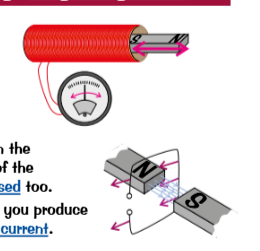
what happens if you move the magnet/conductor in the opposite direction? (generator effect) If you keep the magnet/ the coil moving backwards & forwards….?
If you move the magnet (or conductor) in the opposite direction, then the potential difference/current will be reversed. Likewise if the polarity of the magnet is reversed, then the potential difference/current will be reversed too.
If you keep the magnet (or the coil) moving backwards and forwards, you produce a potential difference that keeps swapping direction - an alternating current.
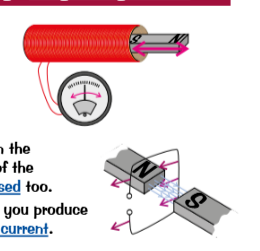
How can you create the same effect? (generator effect) As you turn the magnet…? When you’ve turned the magnet through half a turn…? If you keep turning the magnet in the same direction…?
You can create the same effect by turning a magnet end to end in a coil, or turning a coil inside a magnetic field. This is how generators work to produce ac or direct current (dc)
As you turn the magnet, the magnetic field through the coil changes. This change in the magnetic field induces a potential difference, which can make a current flow in the wire.
When you've turned the magnet through half a turn, the direction of the magnetic field through the coil reverses. When this happens, the potential difference reverses, so the current flows in the opposite direction around the coil of wire.
If you keep turning the magnet in the same direction - always clockwise, say - then the potential difference will keep on reversing every half turn and you'll get an alternating current.
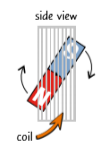
A change in magnetic field can…? Magnetic field created by an induced current always acts…? This means that..?
So, a change in magnetic field can induce a current in a wire. But, as you saw on, when a current flows through a wire, a magnetic field is created around the wire. (that's a second magnetic field - different to the one whose field lines were being cut in the first place.)
The magnetic field created by an induced current always acts against the change that made it (whether that's the movement of a wire or a change in the field it's in). Basically, it's trying to return things to the way they were.
This means that the induced current always opposes the change that made it.
If you want to change the size of the induced pd…? 2 things induced pd (or current) can be increased by..?
If you want to change the size of the induced pd, you have to change the rate that the magnetic field is changing. Induced potential difference (and so induced current) can be increased by either:
Increasing the speed of the movement - cutting more magnetic field lines in a given time.
Increasing the strength of the magnetic field (so there are more field lines that can be cut).
What do alternators do? Their construction is…? As the coil (or magnet) spin…? Instead of a split-ring commutator…? This means…
Alternators rotate a coil in a magnetic field (or a magnet in a coil).
Their construction is pretty much like a motor.
As the coil (or magnet) spins, a current is induced in the coil. This current changes direction every half turn.
Instead of a split-ring commutator, ac generators have slip rings and brushes so the contacts don't swap every half turn.
This means they produce an alternating potential difference
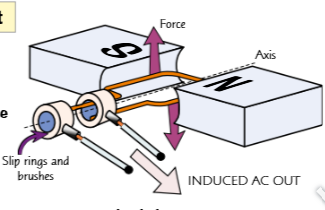
Whats a Dynamo? They have…? What does this do?
Dynamos work in the same way as alternators, apart from one important difference.
They have a split-ring commutator instead of slip rings.
This swaps the connection every half turn to keep the current flowing in the same direction (similar to the motion of a dc motor)
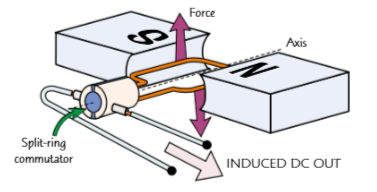
what do oscilloscopes show? What is this for ac? what’s this for dc? The height of line line…? Increasing the frequency of revolutions increases…?
Oscilloscopes show how the potential difference generated in the coil changes over time.
For ac this is a line that goes up and down, crossing the horizontal axis.
For de the line isn't straight like you might expect, but it stays above the axis (pd is always positive) so it's still direct current.
The height of the line at a given point is the generated potential difference at that time.
Increasing the frequency of revolutions increases the overall pd, but it also creates more peaks too.

What are microphones? What do sound waves hit? What does this cause? What does the movement of the coil depend on? This is how microphones convert…
Microphones are basically loudspeakers in reverse.
Sound waves hit a flexible diaphragm that is attached to a coil of wire, wrapped around a magnet.
This causes the coil of wire to move in the magnetic field, which generates a current.
The movement of the coil (and so the generated current) depends on the properties of the sound wave (louder sounds make the diaphragm move further).
This is how microphones can convert the pressure variations of a sound wave into variations in current in an electric circuit.
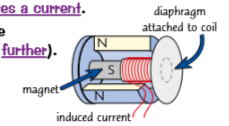
What do transformers change the size of? What do they all have? What happens when an alternating pd is applied across the primary coil? How could this cause a current to be induced? The ratio between primary & secondary pd is the same as…
Transformers change the size of the potential difference of an alternating current.
They all have two coils of wire, the primary and the secondary, joined with an iron core.
When an alternating pd is applied across the primary coil, the iron core magnetises and demagnetises quickly. This changing magnetic field induces an alternating pd in the secondary coil
If the second coil is part of a complete circuit, this causes a current to be induced.
The ratio between the primary and secondary potential differences is the same as the ratio between the number of turns on the primary and secondary coils.
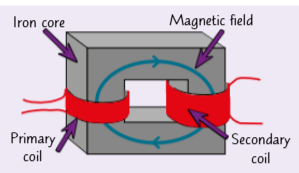
What do Step-up transformers do? What do Step-down transformers do?
STEP-UP TRANSFORMERS step the potential difference up (i.e. increase it). They have more turns on the secondary coil than the primary coil.
STEP-DOWN TRANSFORMERS step the potential difference down (i.e. decrease it). They have more turns on the primary coil than the secondary.
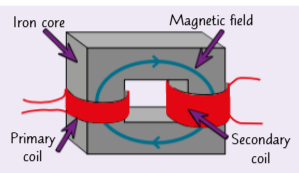
As long as you know the input pd & no of turns on each coil, you can use the equation..?
As long as you know the input pd and the number of turns on each coil, you can calculate the output pd from a transformer using the transformer equation: Vp / Vs = np / ns
VP → input pd (V)
Vs → output pd (V)
np → no turn on primary coil
ns → no turns on secondary coil
Transformers are almost 100% efficient. If you assume that they are, then the input power is equal to the output power. What’s the equation?
VsIs = VpIp
Vs → pd across secondary coil (V)
Is → Current through secondary coil (A)
VP → pd across primary coil (V)
Ip → current through primary coil (A)